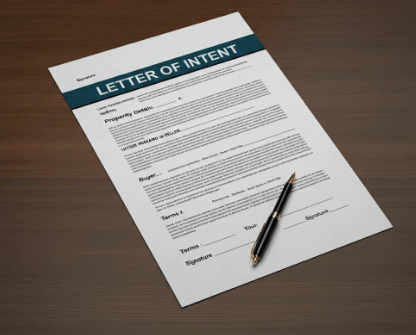Navigating the intricacies of real estate transactions can often be daunting, especially for those new to the field. One crucial document that plays a significant role in the early stages of these transactions is the letter of intent in real estate. This tool outlines the main terms agreed upon by the parties involved and establishes a framework from which a final, binding agreement can be crafted. By understanding the purpose and components of a letter of intent in real estate, buyers and sellers can better manage their negotiations and ensure a smoother path toward closing the deal.
Real estate investors like Steve Daria and Joleigh frequently use letters of intent to outline preliminary agreements before delving into detailed contracts. This document helps them clarify essential terms such as purchase price, contingencies, and closing dates early. By doing so, Steve and Joleigh can mitigate potential misunderstandings and proceed more confidently toward finalizing their real estate deals.
What is a Letter of Intent in Real Estate?
A letter of intent in real estate plays a pivotal role as an initial agreement between parties engaged in property transactions.
It serves as a formal display of intent to proceed with negotiations based on agreed-upon terms, providing a structured framework for future discussions.
Although non-binding, the LOI outlines essential elements such as the proposed purchase price, financing arrangements, and key dates for conducting due diligence.

This document not only clarifies the intentions of both the buyer and seller but also sets expectations regarding the conditions that must be met for the transaction to move forward smoothly.
Importance of Using a Letter of Intent in Real Estate
Using a letter of intent in real estate transactions offers several key advantages that contribute to smoother and more transparent dealings between parties:
Clarity and Roadmap for Negotiations
A letter of intent (LOI) in real estate serves as a crucial tool by providing a structured framework that facilitates effective negotiations between parties.
By clearly outlining the fundamental terms and conditions of the proposed transaction, like purchase price, financing terms, and contingencies, the LOI establishes a roadmap for subsequent discussions.
This clarity not only minimizes misunderstandings but also enhances communication and alignment between the buyer and seller, allowing them to focus on refining details and reaching a mutually beneficial agreement before proceeding to finalize the contract.
Gauge Commitment and Intentions
By outlining preliminary terms in an LOI, parties can gauge each other’s commitment and intentions toward the transaction.
By outlining preliminary terms such as price, conditions, and timelines, the LOI sets the stage for a period of due diligence and evaluation.
This phase allows both the buyer and seller to conduct necessary assessments, review documentation, and ensure alignment on critical aspects of the deal, fostering confidence and trust before finalizing the transaction in a legally binding contract.
Foundation for Due Diligence and Further Actions
The LOI serves as a foundation for conducting due diligence activities such as home inspections, appraisals, and other necessary evaluations.
It establishes timelines and expectations for these actions, ensuring that both parties proceed with confidence and transparency.
Get An Offer Today, Sell In A Matter Of Days
Key Components of a Letter of Intent
A well-drafted letter of intent in real estate typically includes the following components to ensure clarity and completeness:
- Parties Involved: Names and contact details of the buyer and seller.
- Property Description: Detailed description of the property being transacted.
- Financial Terms: Purchase price or rental rate, financing terms, and payment schedule.
- Contingencies: Conditions precedent to closing, such as satisfactory inspection results or financing approval.
- Deadlines: Clear timelines for due diligence, responses, and other critical actions.
How to Draft a Letter of Intent
Drafting an effective letter of intent requires careful attention to detail and adherence to best practices to maximize its effectiveness:
Tips for Drafting:
- Be Clear and Concise: Use straightforward language to ensure all terms are easily understood.
- Include Comprehensive Details: Cover all relevant aspects of the transaction to avoid ambiguities or disputes.
- Review and Legal Consultation: Thoroughly review the LOI and consider legal consultation to ensure accuracy and compliance with local regulations.
Common Mistakes to Avoid:
- Ambiguity: Vague language or unclear terms can lead to misunderstandings.
- Neglecting Contingencies: Forgetting to include critical contingencies can delay or jeopardize the transaction.
- Ignoring Deadlines: Failing to set clear deadlines for actions can hinder the progress of the transaction.
Benefits of Using a Letter of Intent in Real Estate
Understanding the benefits of incorporating a letter of intent into your real estate transactions can help you leverage this tool effectively:
Negotiation Facilitation
A letter of intent (LOI) simplifies negotiations in real estate by providing a structured format that presents the terms and conditions both parties agree upon preliminarily.
This clarity helps streamline discussions, making it easier to focus on resolving any potential issues and reaching a mutual agreement before moving forward with a binding contract.

Building Trust
Using an LOI demonstrates seriousness and commitment to the transaction, which enhances trust between the parties involved.
It shows that both sides are willing to invest time and effort into the deal, laying a foundation of trust that can advance to smoother negotiations and a stronger working relationship.
Flexibility
As a non-binding document, an LOI offers flexibility for parties to make adjustments to terms and conditions before finalizing the contract.
This flexibility is valuable in accommodating changes in circumstances or new information that may arise during the due diligence process, ensuring that the transaction remains fair and favorable to all parties involved.
Conclusion
A letter of intent in real estate serves as a foundational tool that enhances transparency, efficiency, and mutual understanding in property deals. Either you are buying, selling, or leasing real estate, mastering the use of an LOI can streamline negotiations and pave the way for successful deals. By understanding its purpose, components, drafting tips, and benefits, you can leverage the power of an LOI to navigate real estate transactions with confidence and clarity.
**NOTICE: Please note that the content presented in this post is intended solely for informational and educational purposes. It should not be construed as legal or financial advice or relied upon as a replacement for consultation with a qualified attorney or CPA. For specific guidance on legal or financial matters, readers are encouraged to seek professional assistance from an attorney, CPA, or other appropriate professional regarding the subject matter.

